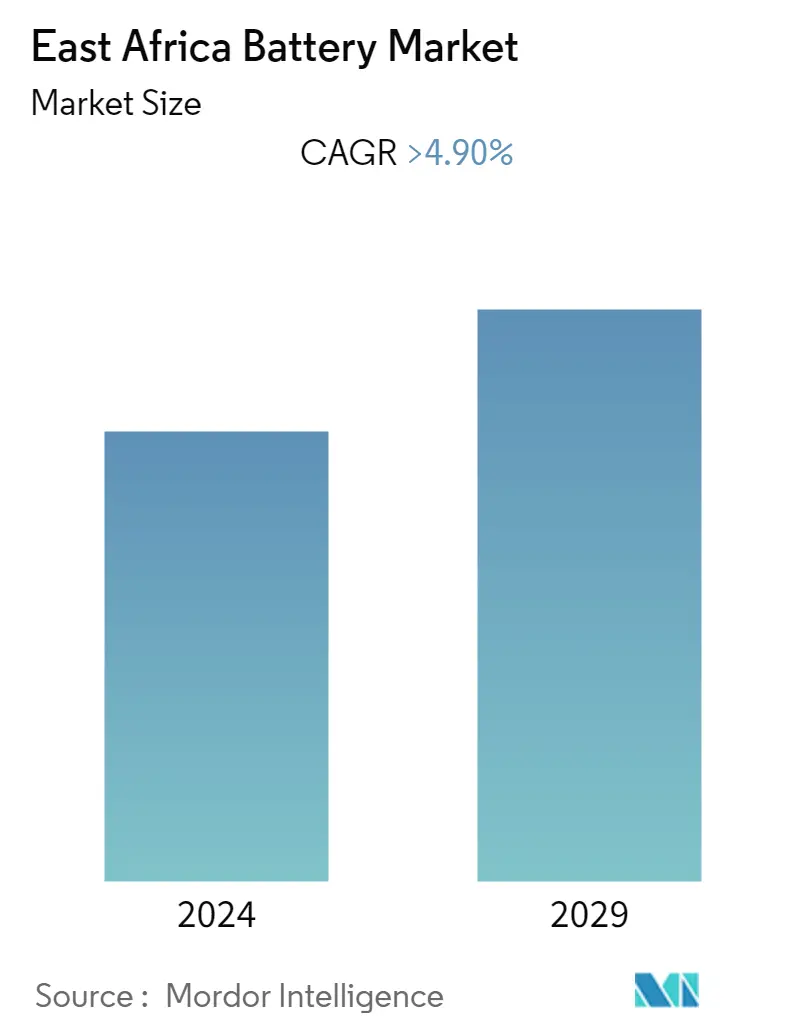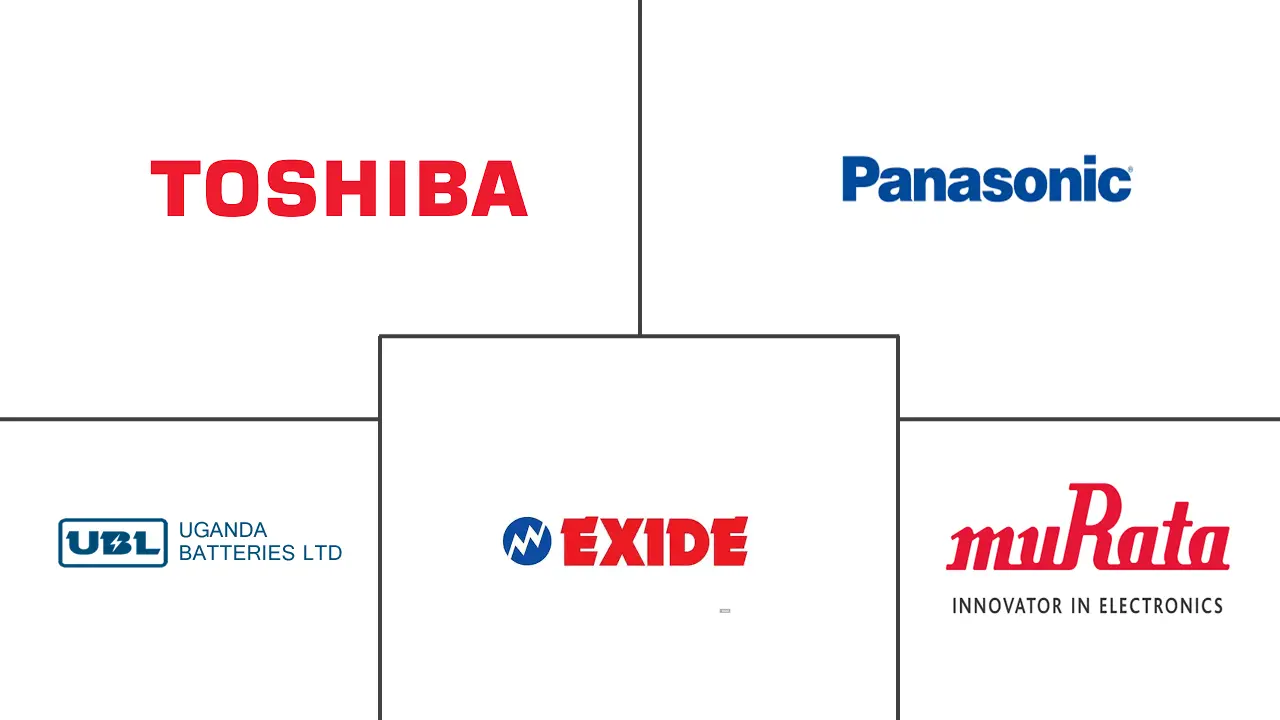Market Size of East Africa Battery Industry

| Study Period | 2020 - 2029 |
| Base Year For Estimation | 2023 |
| Forecast Data Period | 2024 - 2029 |
| Historical Data Period | 2020 - 2022 |
| CAGR | > 4.90 % |
| Market Concentration | Medium |
Major Players
*Disclaimer: Major Players sorted in no particular order |
East Africa Battery Market Analysis
The East African battery market is expected to record a CAGR of more than 4.9% during the forecast period of 2022-2027. The East African battery market was moderately impacted by the COVID-19 outbreak in Q1 2020. The growth of the market declined due to the lockdowns imposed that restricted the supply of batteries and other components as a result of severe disruptions in businesses and the global economy. The COVID-19 pandemic exposed the over-dependency of other countries, especially on China, for imported batteries and key raw materials. Factors such as the increasing adoption of renewable energy by countries in the region and the rapidly growing telecom sector are likely going to drive the East African battery market. However, low domestic and foreign investments are expected to restrain the East African market during the forecast period.
The lithium-ion battery segment, due to the significant reduction in the manufacturing and retail cost, has become more accessible to people for everyday use, such as in mobile phones and other electronic devices, and is likely going to be the fastest-growing segment in East African battery market.
The increasing deployment of renewable energy and growing usage of battery electric vehicles across Uganda and Rwanda are likely to create several opportunities for the East African battery market in the future.
Ethiopia is expected to be the fastest-growing market for the East African battery market during the forecast period because of its increasing solar and wind energy installations and upcoming projects to generate clean energy.
East Africa Battery Industry Segmentation
The East African battery market report includes:
| Type | |
| Primary Battery | |
| Secondary Battery |
| Technology | |
| Lithium-ion Battery | |
| Lead-acid Battery | |
| Other Technologies |
| Application | |
| Industrial Batteries | |
| Portable Batteries | |
| Other Applications |
| Geography | |
| Kenya | |
| Ethiopia | |
| Tanzania | |
| Rest of East Africa |
East Africa Battery Market Size Summary
The East African battery market is poised for significant growth, driven by the increasing adoption of renewable energy and the expanding telecom sector. The market experienced a moderate setback due to the COVID-19 pandemic, which highlighted the region's reliance on imported batteries and raw materials, particularly from China. Despite these challenges, the market is expected to recover and grow, with the lithium-ion battery segment anticipated to be the fastest-growing due to its decreasing manufacturing and retail costs. This growth is further supported by government initiatives promoting electric vehicles and renewable energy projects across countries like Uganda, Kenya, and Rwanda. Ethiopia, in particular, is expected to lead the market's expansion, fueled by its investments in solar and wind energy installations and efforts to enhance its telecom infrastructure.
The East African battery market is characterized by moderate fragmentation, with key players such as Toshiba Corporation, Murata Manufacturing Co. Ltd, Exide Industries Ltd, and Panasonic Corporation actively participating. The region's focus on renewable energy and electric vehicles is creating numerous opportunities for battery storage systems, especially in Ethiopia, where significant projects are underway to boost solar capacity and develop battery storage solutions. The government's efforts to open the telecom market to competition are also expected to stimulate the mobile battery market. Additionally, projects like the solar mini-grid initiatives in Uganda and Rwanda's hybrid mini-grids with battery storage are indicative of the region's commitment to enhancing its energy infrastructure, further supporting the growth of the battery market.
East Africa Battery Market Size - Table of Contents
-
1. MARKET OVERVIEW
-
1.1 Introduction
-
1.2 Market Size and Demand Forecast in USD billion, till 2027
-
1.3 Recent Trends and Developments
-
1.4 Government Policies and Regulations
-
1.5 Market Dynamics
-
1.5.1 Drivers
-
1.5.2 Restraints
-
-
1.6 Supply Chain Analysis
-
1.7 Porter's Five Forces Analysis
-
1.7.1 Threat of New Entrants
-
1.7.2 Bargaining Power of Consumers
-
1.7.3 Bargaining Power of Suppliers
-
1.7.4 Threat of Substitute Products and Services
-
1.7.5 Intensity of Competitive Rivalry
-
-
-
2. MARKET SEGMENTATION
-
2.1 Type
-
2.1.1 Primary Battery
-
2.1.2 Secondary Battery
-
-
2.2 Technology
-
2.2.1 Lithium-ion Battery
-
2.2.2 Lead-acid Battery
-
2.2.3 Other Technologies
-
-
2.3 Application
-
2.3.1 Industrial Batteries
-
2.3.2 Portable Batteries
-
2.3.3 Other Applications
-
-
2.4 Geography
-
2.4.1 Kenya
-
2.4.2 Ethiopia
-
2.4.3 Tanzania
-
2.4.4 Rest of East Africa
-
-
East Africa Battery Market Size FAQs
What is the current East Africa Battery Market size?
The East Africa Battery Market is projected to register a CAGR of greater than 4.90% during the forecast period (2024-2029)
Who are the key players in East Africa Battery Market?
Toshiba Corporation, Murata Manufacturing Co., Ltd, Panasonic Corporation, Exide Industries Ltd and Uganda Batteries Limited are the major companies operating in the East Africa Battery Market.

